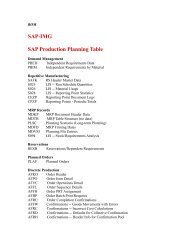Object Oriented ABAP
Object Oriented ABAP
Object Oriented ABAP
Create successful ePaper yourself
Turn your PDF publications into a flip-book with our unique Google optimized e-Paper software.
BI_OBJECT~EXECUTE_DEFAULT_METHOD<br />
BI_OBJECT~RELEASE<br />
A class that implements the IF_WORKFLOW interface can be used in any workflow. The<br />
class is automatically released for use in workflows when the interface is implemented.<br />
Therefore, we can only make compatible changes to a class after implementation (we<br />
cannot delete attributes, change types or delete methods). There is no where-used list to<br />
show which workflows the class is used in.<br />
Internal classes of an application should not implement the IF_WORKFLOW interface, since<br />
this could mean that each method of the class is used in the workflow. Therefore, we should<br />
encapsulate the workflow functions in another class that calls the selected methods of the<br />
internal class.<br />
Each method of the IF_WORKFLOW Interface as mentioned earlier has its distinct<br />
functionality, which is discussed below.<br />
16. BI_PERSISTENT~FIND_BY_LPOR Method:<br />
If we want to convert a persistent saved display of an object into an instance of the<br />
corresponding <strong>ABAP</strong> class, SAP Web flow Engine calls the BI_PERSISTENT~FIND_BY_LPOR<br />
method.<br />
Features:<br />
The method parameter LPOR is the persistent object reference and is of SIBFLPOR structure<br />
type. A reference of BI_PERSISTENT type is returned.<br />
The following table shows the components of the SIBFLPOR structure:<br />
Field Description<br />
CATID Describes the object type ( CL for <strong>ABAP</strong> classes)<br />
TYPEID <strong>ABAP</strong> class name<br />
INSTID <strong>Object</strong> key. The key is limited to 32 characters.<br />
We can implement this method in several ways. In the case of persistent classes we can<br />
create the <strong>ABAP</strong> object instance using the generated classes. In the case of individual<br />
persistence management we have to implement the individual actions (such as creating an<br />
instance, performing an existence check, entering public attributes, and so on) manually<br />
within the class.<br />
Instance management takes place automatically in the case of persistent classes. In the<br />
case of individual persistence management we also have to carry out instance management<br />
by class. The SAP Web Flow Engine does not provide any instance management. We must<br />
therefore implement our own instance management in the case of individual persistence<br />
management.



